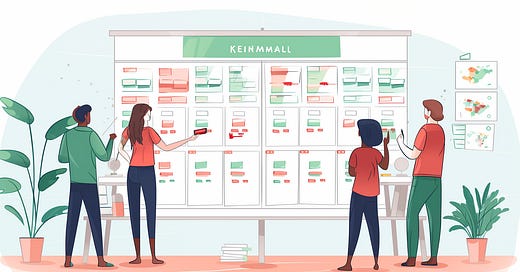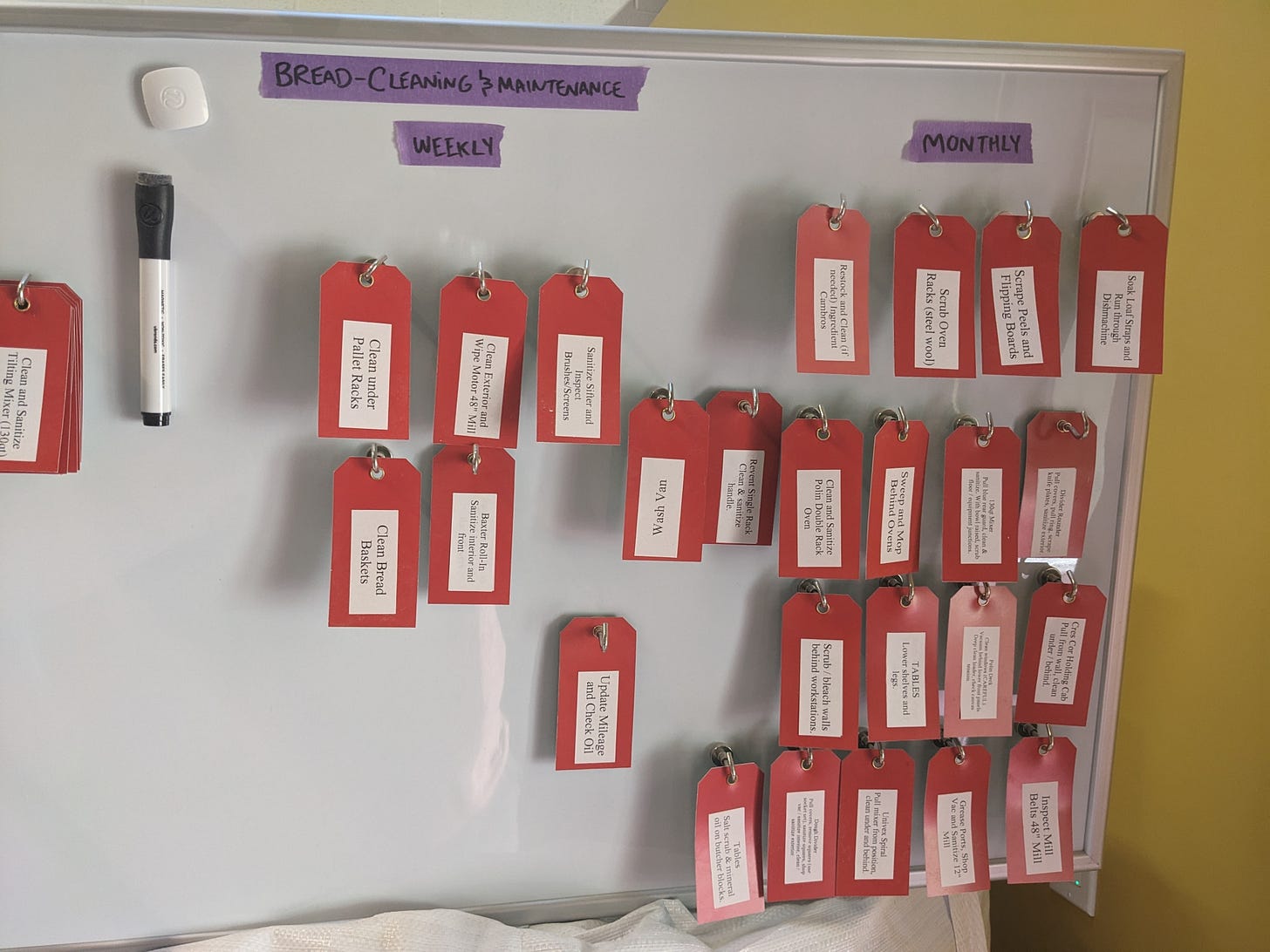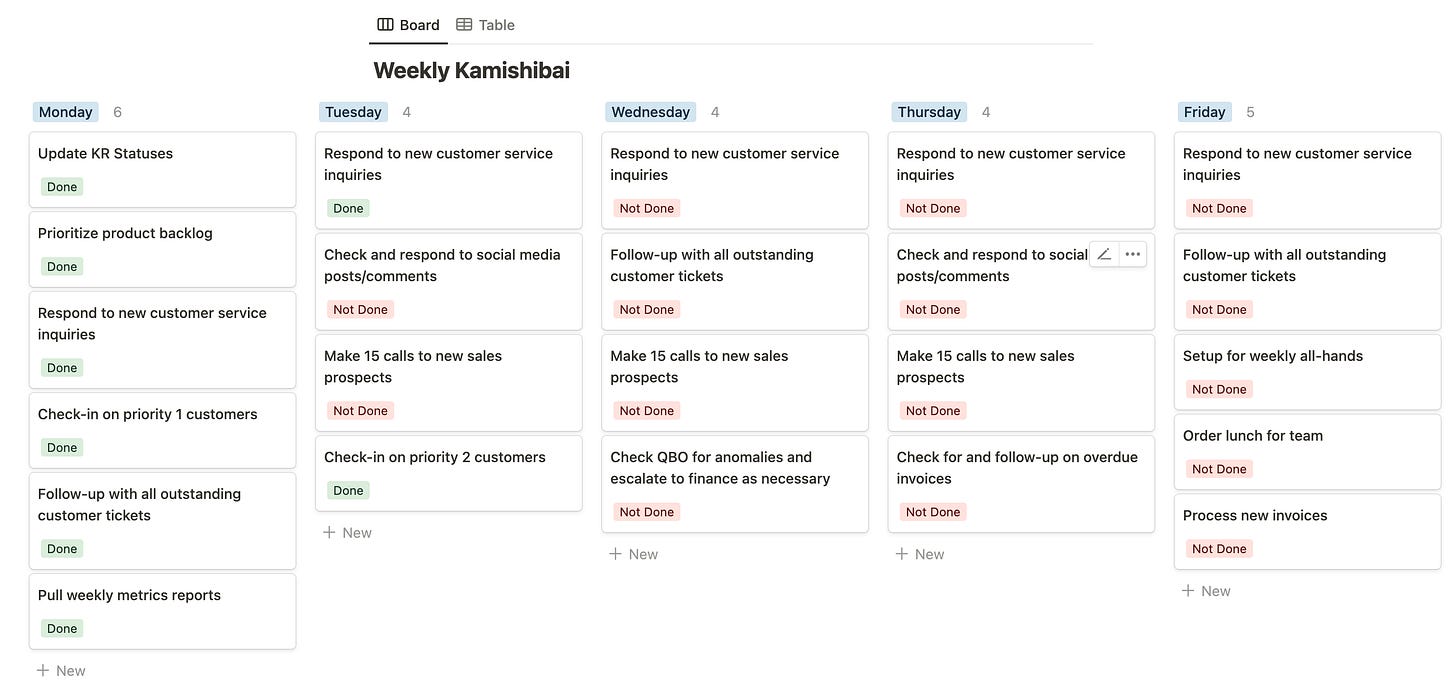Kanban boards are excellent for visually tracking the ownership and progress of unique tasks within a team. Kanban has become such commonplace that they’re included in workflow management tools like Trello, ClickUp, Airtable, Asana, and Notion as a default task view option.
While Kanban boards are good for non-repetitive work management, they are not the best tool for handling recurring work management. Enter the Kamishibai board (pronounced as com-ee-she-bye) — the yin to Kanban’s yang. Most teams perform a combination of recurring and non-recurring tasks, and it’s in organizing the latter that the Kamishibai shines.
A Kamishibai board is a simple framework for visually tracking the ownership and completion status of recurring tasks — the stuff that keeps the lights on and the trains running on time.
Kamishibai was originally introduced in the Toyota Production System (TPS) to keep track of and visualize the maintenance schedules for various factory floor machines. Maintenance tasks are often overlooked or deprioritized, even though neglecting them can lead to significant costs in the long run. If your team is struggling to manage routine tasks, we recommend creating a Kamishibai board.
Let’s get into some examples of what we mean by recurring and non-recurring. Say a development team handles new feature requests and bug fixes, creating user stories for their backlog. These are the team’s non-recurring tasks, great for using Kanban to organize. The team also has tasks like code review, performance monitoring, and documentation audits. This is the recurring stuff — Kamishibai can handle that.
The same holds true across an organization. Take Finance, for example. The team has to put together a data room for the upcoming round of fundraising ⇒ non-recurring ⇒ Kanban. They also have to run payroll and close the books each month ⇒ recurring ⇒ Kamishibai.
To make it super simple…
Recurring tasks (daily, weekly, monthly, quarterly) go in the Kamishibai
Non-recurring tasks (unique, resist repeatability) go in the Kanban
Setting up a Kamishibai board is straightforward. Think of it as a variation of a Kanban board, but instead of stages of work, you use cadences like daily, weekly, or monthly. Rather than moving tasks across columns, you keep recurring tasks in their designated time period column and change their status from "Not Done" to "Done." That's the basic structure.
One of the most practical examples of a Kamishibai in action comes from an unlikely place — a bakery. The team followed a structured weekly schedule:
Mondays for croissant preparation, pies, and pastries
Tuesdays for baking croissants, bread, catering, and so on…
Most of their tasks are repeated every week. To better delegate, they pinned the weekly tasks on a Kamishibai board. It allowed everyone in the kitchen to see what tasks were completed and which ones were pending for the day or week.
Let’s Create a Kamishibai for Your Team
Step 1: Find a bulletin board, whiteboard, or a suitably empty wall. Kamishibai boards are typically physical, although they can be adapted to digital tools as well (more details later).
Step 2: Choose a recurring time scale that suits your needs, like a day, a week, a month, or even a year. This time scale will determine the columns on your board. For example, if you choose a week, you'll have seven columns representing each day.
Step 3: Create two-sided cards in different colors, like red and green, and list out tasks — one task per card (remember to write the task on both sides). At the start of each time period, flip all the cards to their red side to indicate that the tasks are yet to be done. As tasks are completed throughout the week, flip the respective cards to the green side to indicate completion. This way, everyone can easily see the status of all tasks.
To make a digital version of a Kamishibai, the same principles apply. Time scales are your columns, tasks are placed in each column, and each task has a possible status of Done or Not Done.
Benefits of Digital Kamishibai
Particularly with tools like Trello and Notion, each task card can also serve as a how-to document in the description section. When all of your most critical maintenance work is organized in a central location, and each task has an accompanying how-to, suddenly your Kamishibai unlocks additional use cases:
Onboarding artifact — use the inherent organization of the Kamishibai board with its digital documentation power-up to easily onboard new employees.
Retraining tool — does the way you handle a recurring task change over time? Not a problem, reflect that change in your how-to documentation and ping your team to ensure they follow the new instructions the next time around.
Delegation instrument — whether you’re on holiday, moving departments, or won the lottery and retired, having the how-to documentation inside of each Kamishibai task helps offload ownership over cyclical tasks more easily. The lights stay on and your team doesn’t miss a beat.
Nuance repository — even the most repetitive of tasks sometimes requires a level of nuance to do well. Capture notes like “If no code was released last week, mark this complete and move on” to ensure whoever takes on a piece of repetitive work has the information they need to efficiently complete the task.
We’ve created templates using a few different, popular tools to get you started
Trello Kamishibai
Notion Kamishibai

Google Sheet Kamishibai

Scaling Kamishibai
Whether you opt for the analog or digital, Kamishibai is a useful framework to implement no matter the scale of your business, but there are a few simple guidelines to ensure it remains manageable as you grow.
For small businesses and early-stage startups (< 4 distinct teams)…
A single, shared Kamishibai will do nicely. As you add more people to the org, you can start playing around with assigning ownership to certain tasks to avoid folks tripping over one another and duplicating work.
Keep your eyes peeled for an overly-crowded Kamishibai. If you find yourself sifting through a mountain of task cards to find a few you can pull and complete, it may be time to split your board. You’ll find this typically happens as the org chart becomes more complex and you get beyond the days when every employee “wore many hats.”
For larger companies and growth+ startups (> 3 distinct teams)…
As your company grows you’ll want to create Kamishibai boards first on the department level, and as growth continues, at the team level.
The idea is to continue to organize your recurring work at the highest level possible where most people are qualified to complete every task on the board if they need to.
Kamishibai is a straightforward and powerful framework that scales across growth and medium to keep your team aligned and aware of the most critical recurring tasks to the business. Plus, there’s nothing quite like the simple pleasure of flipping that task from red to green. It’s the little things.










